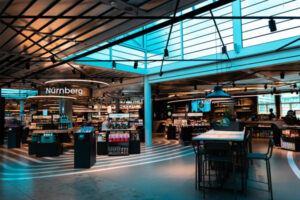By Moritz Felix Lück
1. Assume Responsibility
ESG revolves around the future of the retail real estate industry – nothing more, nothing less. Changes constantly occur, and these changes affect our businesses, our societies, and the environment. In terms of sustainable development, retail parks have to meet a variety of requirements in order to be able to influence that particular asset class. The EU’s Green Deal, which demands great effort from the retail real estate industry in order to ensure a greenhouse gas-neutral EU by 2050, in close cooperation with other economic sectors, stipulates the direction of development. The industry has increasingly recognized that it has a leading role to play as a co-creator of a sustainable future and that it must embrace its role in a creative way.
Such a level of responsibility is clearly being pointed out, with growing frequency, to other players in the market and in society. Sustainability issues have become key factors in the real estate management decisions of many companies, and not just since the onset of global climate-related demonstrations. The EU and the German government are considered the main drivers of the sustainable development of retail parks. They have used the finance sector, which has taken up the cause of sustainable finance, as a vehicle for the transformation of the entire economy.
In that respect, retail real estate owners have recently started to rely on the concept of impact investing through the implementation of initial measures. In addition to the pursuit of competitive returns, such an investment approach also focuses on the positive impact on ecological and social solutions. For retail parks, completely new opportunities to help shape society are created – after all, the ultimate goal is not only to make shopping more ecological, but also to jointly create added value for the planet and, of course, for investors.
2. Seize Opportunities
Change always provides opportunities. As a result, it is important to further develop retail real estate from the point of view of sustainability. There are numerous points from which such an effort can be started. In order to prevent the need for the construction of new buildings, refurbishments or expansions can be pursued. In the course of such comprehensive restructuring, many measures can be implemented to ensure the sustainable orientation of a retail real estate property. In addition to the modernization of technical systems, for example, the installation of photovoltaics systems on the roofs, the natural design of the grounds, or the use of parking spaces for solar energy generation can also contribute to the sustainability of retail parks. Photovoltaics systems do not necessarily have to be installed and operated by the investor. Good operators have partners that rent the necessary spaces and manage such facilities independently. Nevertheless, such activities allow investors to show their stakeholders that they are promoting sustainability. They can also profit economically from the long-term, cheaper green electricity. Effective 2021, the CO2 tax will take effect.
Centers can play an active role in social change. The promotion of new mobility through the development of e-charging infrastructures can also serve as a contribution in that direction. It can provide retail parks with a lot of previously unused potential. Centers that allow their customers to conveniently recharge their e-cars during shopping hours can increase footfall, rental income, and customer satisfaction in equal measure, while simultaneously contributing to the image enhancement of their shopping locations. Such activities all contribute to the environment, society, and economic sustainability – and they support local retailers.
Similar opportunities have arisen from Green Facility Management (Green FM), ranging from energy management and the use of ecological materials, to the reduction of water consumption and ecological waste management, to ensuring good indoor air quality. Green operations will help retail parks increase their overall attractiveness. In addition to showcasing their commitment to the environment, it will also enable them to demonstrate their commitment to the well-being of center visitors as well as employees. Consequently, Green FM also does well to safeguard jobs and the future viability of retail real estate.
3. Operate within Networks
The notion that the future belongs to networked organizations first appeared in the Retail Parks Report of 2015. Partnership and interdependence among all parties involved in the construction, management, and use of retail real estate helps to achieve common goals. Thus, the transparency obligations imposed on investors can only be fulfilled in close cooperation with service providers, such as center operators and facility management partners.
That applies, in particular, to sustainability goals. In that regard, retail parks are part of a network of investors, tenants, service providers, and consumers, all of whom must do their parts to achieve the desired results. Networking within contractual chains ensures compliance with ESG rules. Sustainability indicators must be specified by the investors and implemented by all partners. That applies, for example, to interconnected rental contracts, FM contracts, and property management contracts. As a result, the demands on governance and on structures and processes will increase for asset managers and their business partners, because, in the future, sustainability will involve more than just proving the sustainability of all fund products. For new funds and other financial products, investors will have to determine what sustainability objectives they wish to pursue.
In such cases, the entire center management network is called upon to creatively and agilely adapt its specifications. Ultimately, it is in the interest of all those involved to ensure balanced economic performance. That is the only way in which all sides can benefit in the long term. Numerous shopping centers have demonstrated just how it can be done. The occasional glance at other asset classes may certainly be worthwhile in that respect.
4. Question Sustainability Offers
Sustainability is a marathon, not a sprint. As a result, retail parks cannot be designed to be environmentally friendly overnight. Nevertheless, moving in that direction will pay off in the long term. Exploring new paths is an important part of the journey. However, such paths should always be checked for their environmental compatibility. Much of what is offered as a solution for sustainability, in the context of transformation, proves to be a sham upon closer inspection.
For example, assessing the energy consumption impact of digitization, in terms of environmental balance, is urgently recommended. Data centers, apps, and video streaming, for example, are real energy guzzlers. In addition, there are the ecological consequences that have long been associated with e-commerce: increased packaging waste, CO2emissions due to multiple journeys, and additional environmental costs due to return journeys and higher levels of waste.
By contrast, retail parks can sometimes perform better than originally expected; for example, they are often located on the way to work for center customers and offer a broad mix of industries under one roof via one-stop shopping.
In general, therefore, the same applies here: Simple solutions are not always the best, and nothing is purely black or white. On the path to sustainability, it is always advisable to approach and weigh the options in order to identify new paths and find viable solutions.
5. Take Matters into Your Own Hands
With regard to environmental compatibility, retail parks are under pressure. Eighty percent of all institutional investors in Germany have already begun to incorporate sustainability criteria into their decisions – and the trend is on the rise. In principle, that also applies to retail properties, even though the results of the assessment at the time of purchase are often not very relevant.
This is certain to change in the foreseeable future as the consideration of ESG criteria in investment decisions is increasingly becoming a competitive advantage in the battle for investor money. Centers that are not geared toward sustainability or cannot be geared toward economically viable costs may become an avoidable long-term risk for investors. The consequences could have a severe impact on them. Retail parks have proven that they are economically more robust than other asset classes, for example, during the coronavirus crisis, due to their high proportion of local supply.
Therefore, it is high time to start moving towards sustainability. Even though the first step may be difficult, there may be an initial lack of orientation, or the expenditure may seem too high: The effort will pay off – in two ways. Firstly, decision-makers will benefit from greater transparency with respect to the long-term consequences of their business activities with regard to climate, resource consumption, and social standards. Secondly, sustainability reporting will provide them with important key figures on the future viability of their retail parks.
In that respect, the need for sustainability also represents a huge opportunity. After all, the sooner retail parks take the necessary steps, the sooner they can ensure the future viability of their own business models.
* ”Fachmarktzentren in Deutschland” (Retail Parks in Germany), published by MEC together with Dr. Lademann & Partner, Nuveen Real Estate, Savills, and Wisag.






